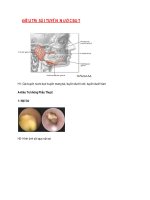Sỏi tuyến nước bọt
Bạn đang xem bản rút gọn của tài liệu. Xem và tải ngay bản đầy đủ của tài liệu tại đây (2.42 MB, 117 trang )
SALIVARY GLAND
NEOPLASMS
Presenter: Dr Gulzar Ahmad Bhat
Moderator: Dr M. Inam Zaroo
Associate Profesor Plastic Surgery
Y
M
O
T
A
AN
PAROTID
Major salivary gland
Ectodermal origon
Irregular in shape extend from zygoma superiorly to oblique line
of sternomastoid inferiorly and to mid point of massetor muscle
Superficial & deep lobes
Processes( glenoid , pterygoid ,facial)
parotid duct (Stensen’s duct) & accessory gland
Covered by investing fascia of the neck & contain lymph node mainly in
superficial lobe
Structures within the gland:
Facial nerve
Retromandibular vein
External carotid artery
Parotid L.N
STRUCTURES WITHIN GLAND
Deep lobe lie in parapharyngeal space
Anterior: Infratemporal fossa
Posterior: Carotid sheath & styloid process
Medial: Superior constrictor muscle of pharynx which is
separating the gland from oropharynx & tonsils
RELATIONS
BLOOD SUPPLY
Superficial temporal & maxillary arteries
Retromandibular vein
LYMPH DRAINAGE
Parotid & deep cervical L.N
NERVE SUPPLY
PARASYMPATHETIC
Inf. Salivary nucleus
CN IX
Lesser petrosal Nerve
Otic ganglion
Auriculoteporal N. (CN V3)
Parotid gland
SYMPATHETIC:
Sympathetic trunk
Sup.cervical ganglion
Ext.carotid artrey plexus
Parotid gland
THE SUBAMANDIBULAR SALIVARY GLAND
It is wedged between the mandible & the floor of the mouth (upper part deep to the mandible)
It has large superficial part & small deep part
Its duct opens in the floor of the mouth at the tip of the sublingual papilla
THE SUBLIGUAL SALIVARY GLAND
A small gland which lies
between the mandible &
tongue
It raises the floor of the
mouth forming sublingual
papilla
It opens by many ducts
directly to the floor of the
mouth & into the
submandibular duct
NERVE SUPPLY OF THE SUBMANDIBULAR & SUBLINGUAL
SALIVARY GLANDS
• Parasympathetic: Facial (7th) nerve through the chorda tympani (fibers relay in the submandibular
ganglion)
• Sympathetic: Superior cervical symp. Ganglion
• Sensory: The lingual nerve
PHYSIOLOGY
25% of total salivary volume secreted by parotid
Organic & inorganic compounds
Serous type ( mucin , enzymes)
Produced & stored in the Acinus & modified in the ductal cells
Parasympathatic increases the secreation
Several reflexes (sight,smell,taste…etc) augment the secretion rate
Saliva has several important functions:
1. Lubricant to aid in swallowing food
3. Digestion by an emulgation of food and enzymatic cleavage
3. Mechanical cleaning
4. Immunologic defense
5. Mediation of taste sensations
6.Excretion of endogenous and exogenous materials, for
group–reactive substances, iodine, and viruse
7. Buffering effect
example, antibodies, blood
NE
S
M
S
A
L
P
O
CLASSIFICATION
• Mainly classified into four groups
» Adenomas
» Carcinomas
» Miscellaneous
» Tumor-like lesions
Benign/malignant
Tumour type
Clinical site
Clinical feature
Benign
Pleomorphic
adenoma
Parotid commonest
Painless, slow-growing
firm mass
Malignant
Oncocytic tumour Parotid gland
(Warthin’s tumour)
Soft to firm, occasionally
bilateral, mass
Mucoepidermoid Parotid
carcinoma
commonest
Slow-growing firm
mass
Adenoid cystic
Minor salivary
glands
commonest
Slow-growing
submucosal
nodule in the upper
aerodigestic tract
Acinic cell
tumour
Parotid gland
Slow-growing nodule
Adenocarcinoma
Minor salivary
gland
Submucosal lump
CLASSIFICATION
ADENOMAS
1 Pleomorphic adenoma
3 Myoepithelioma (myoepithelial adenoma)
5 Basal cell adenoma
7 Warthin’s tumor (adenolymphoma)
9 Oncocytoma (Oncocytic adenoma)
11 Canalicular adenoma
12 Sebaceous adenoma
CLASSIFICATION (Cont’d)
8 Ductal Papilloma
a) Inverted ductal papilloma
b) Intraductal papilloma
c)
Sialadenoma papilliferum
9 Cystadenoma
d) Papillary cystadenoma
e) Mucinous cystadenoma
CLASSIFICATION (Cont’d)
Carcinomas
1 Acinic cell carcinoma
2 Mucoepidermoid carcinoma
3 Adenoid cystic carcinoma
4 Polymorphous low-grade adenocarcinoma
5 Epithelial-myoepithelial carcinoma
6 Basal cell adenocarcinoma
7 Sebaceous carcinoma
8 Papillary cystadenocarcinoma
9 Mucinous adenocarcinoma
10 Oncocytic carcinoma
CLASSIFICATION (Cont’d)
11 ) Salivary duct carcinoma
12 ) Adenocarcinoma
13 ) Malignant myoepithelioma
14 ) Squamous cell carcinoma
15 ) Small cell carcinoma
16 ) Undifferentiated carcinoma
1
CLASSIFICATION (Cont’d)
Miscellaneous
1) Nonepithelial tumors
2 ) Malignant lymphomas
3 ) Secondary tumors
4 ) Unclassified tumors
Tumour-like lesions
1) Siladenosis
2 ) Oncocytosis
3 ) Necrotizing sialometaplasia (salivary gland infarction)
4 ) Benign lymphoepithelial lesion
5 ) Salivary gland cysts
6 ) Chronic sclerosing sialedenitis of submandibular gland
(Kuttner tumor)
7 ) Cystic lymphoid hyperplasia in patients with acquired immunodeficiency syndrome
INCIDENCE
Salivary gland tumors >>> 3-4% of all head & neck
neoplasm
70% originate in parotid gland
> 70% of them are Benign
70% of them Plemorphic adenoma
10% of parotid tumors Mucoepidermoid carcinoma









